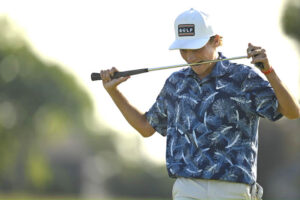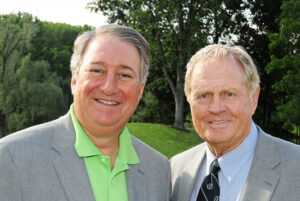Lack of regulation is to blame, he says
The USGA’s and R&A’s proposed model local rule to reduce the driving distances of the game’s longest hitters in elite competitions has been met with criticism on a variety of fronts – from coming long after the horse has left the barn to breaking the connection between top PGA players and your Average Joe.
The rule, announced on March 13 and scheduled to take effect Jan. 1, 2026, if adopted, maintains the current standard of 320 yards as the maximum distance a ball can travel, but it changes the swing speed used in testing from 120 to 127 miles an hour – closer to the average swing speed of PGA Tour players.
Since a top-shelf modern golf ball like the Titleist Pro V1 and TaylorMade TP5 already exceed the maximum distance when hit by a Tour player, the rule means the game’s top players will have to play a throttled-back ball and likely see 14 to 15 yards or more shaved off their drives.
Enter Tom Marzolf, senior designer with the Fazio Design Group and a former president of the American Society of Golf Course Architects. He has mixed feelings about the proposed rule and thinks the USGA should have acted decisively to limit distance decades ago.
Marzolf started with the Fazio Design Group in the early 1980s and has spent a career designing, renovating and restoring golf courses while trying to keep up with technology-driven increases in distance.
He’s seen firsthand how the modern golf ball, especially, threatens to make obsolete classic courses designed by the greats of the 20th Century. His resume includes restorations of Merion Country Club, Oakmont Country Club, Rivera Country Club, Firestone Country Club and Fox Chapel Golf Club. He’s also consulted to prepare some of those courses as venues for U.S. Opens and U.S. Women’s Opens.
This interview, which first appeared on First Call Golf, has been edited for length and clarity.
Q: How did we get to this point?
A: Well, I think a lot of the mistakes were made. Now, looking back, it’s easy to call it a mistake, but when the first metal driver was made by TaylorMade and handed to the USGA and they asked, is this a legal club? They could have easily passed a rule at that time that said a wood has to be made out of wood. And they could have said no metal drivers and the game would’ve kept on playing persimmon.
They didn’t understand the metal club at the time. They didn’t understand that it was allowing more energy transfer to the ball at impact. They cut the club open, they looked at it, said, well, this is fine, go ahead and use it. And so, later, finding out that a Great Big Bertha driver face was flexing and the ball held on the face longer and 5 percent more energy was transferred to the ball at impact – or five yards in a hundred yards – because of titanium face on a driver, they found out after the fact, but they called it legal.
That’s been the history of the USGA ball and club testing facility. It’s a very small facility. They have talented people there, but they have a series of tests and they just repeat the same tests. Well, the equipment changed and other tests should have been added. … There’s no test on the flight of a golf ball and energy absorption of the ball. And no real aerodynamics-in-flight tests at all. There never have been. And that’s allowed the ball manufacturers to make a ball that stays in the air longer, carries farther and has led to the dilemma that we’re in right now. They keep doing the same tests and keep getting beat by the manufacturers.
Q: But the metal driver clearly helped amateurs. We saw real distance gains for the average player when clubs like the Big Bertha and Great Big Bertha hit the market.
A: I was at the ball testing facility when Frank [Thomas] ran it. He was definitely pro equipment. I mean there was a tilt at that time that equipment was good for the game, that we needed to grow the game and if people would get excited about new equipment or a new shaft, it would be good for the game. So, it was an innocent move to try to allow the game to grow.
But the lack of scientific review of the equipment has led to golf courses being too short. There wasn’t really a goal to protect old courses until it became a problem. Because it wasn’t a problem until it was a problem, you know, they missed it.
Q: Talk about the effect on older courses.
A: We’ve seen every club have to add back tees and lengthen their courses at their own expense. I put all the back tees in at Winged Foot for the 2006 US Open. I worked for Oakmont and added all the back tees for the 2007 Open. We had one tee at Winged Foot that cost a quarter million dollars because they had to blast into rock. All I’m saying is every architect has done this in their lives, helping clubs get longer. Why? Why do you have to lengthen all these golf courses and why does each club have to pay the bill for lack of regulation?
Q: I guess you could say it’s the architects’ full employment act.
A: Well, I don’t know that it really benefits us. I got plenty of money building brand-new golf courses. The country club stuff was more of a service to a club and it’s hard to make a whole lot of money building back tees.
Q: And I guess, it’s got to be a little bit repetitive to keep doing the same thing again and again over 20-some years.
A: Yeah, exactly. You know, can see that at every club in the country. If you wanted to be a championship- or tournament-level course, you had to go on and do it. … You now have 8,000-yard golf courses popping up right now. Everything in the ‘20s was 6,200 yards, 6,300 yards. Pinehurst No. 2 used to be that length. Augusta National used to be that length. Now, because of lack of regulation and equipment advances, courses are 1,200 to 1,500 yards longer. Then, there’s the sustainability issue. I say it’s unsustainable to continue to have more acreage under care, under irrigation, under mowing. What’s the goal for the game now? Rein it in and put a lid on that and define it and get the game to agree to something for the common good.
Q: Well, isn’t late better than never?
I think it would be easier to agree to some kind of “common good” statement rather than this model local rule, because it’s only for elite players and now you have to define what an elite player is. It just seems like an oddity.
It’s an attempt to walk back time and I get it, but they should come right out and admit and indicate, how at every point in time, equipment added distance, and build a case for sustainability and admit some of the errors of the past. I think that’s a plausible explanation as to why you’re throwing this model rule down – because you’re basically trying to change the game and not admit that you’re not very good at regulating equipment.
Dan Vukelich is the Online Editor of Alabama Golf News.
Have a story idea or a news item to report to Alabama Golf News? Email bamagolfnews@gmail.com
Featured image:The Golf Warehouse













